16 — 22

 ESTONIAN DESIGN HOUSE
ESTONIAN DESIGN HOUSE

16 — 22

 ESTONIAN DESIGN HOUSE
ESTONIAN DESIGN HOUSE
Discover the Soul of Estonian Design: Tradition Meets the Future in Circularity and Digital Innovation
May 16-22, 2024, Lafayette Gallery, SOHO
Nestled in the heart of Northern Europe, Estonia has emerged as a powerhouse in the global design and digital innovation scene. Join us at Upmade in Estonia to learn how the traditional core of minimalist philosophies of Estonian design became the cutting edge of sustainability and digital innovation. This exclusive event is taking place for the first time in New York City, with top design leaders from Estonia in attendance who will share and discuss the roots of Estonian Design, its unique aesthetics, and its contemporary successes. You will find out why this tiny country is now recognized as having the “most unicorns per capita in Europe” and “the most start-ups per capita in Europe,” and how it became the world’s first 100% digitally transformed society. You will hear the backstory of the startup culture where products like Skype were born, and how Estonia became the world leader in digital governance, its innovative e-Residency program, and how this is revolutionizing the creative and entrepreneurial landscape.
Upmade in Estonia transcends being merely an exhibition; it serves as a guiding light for the future of design. This event is a collaborative effort between the Estonian Association of Designers*, the Estonian Academy of Art*, and e-Residency. Supported by the Ministry of Culture, the Cultural Endowment, Enterprise Estonia, and the Consulate General of Estonia in New York, it showcases the collective com-
mitment to fostering creativity and innovation. Curated by Ilona Gurjanova, President of the Estonian Association of Designers, and Reet Aus, PhD, an environmental activist, the exhibition’s layout, including cardboard furniture, is the creation of Tarmo Luisk, with the exposition table designed by Annike Kaldoja. In today´s world, where overconsumption leads to an abundance of waste and ephemeral products, Estonia presents efficient and creative alternatives. Rooted in centuries-old traditions, Estonians have maintained a deep connection with nature and their Northern European heritage whilst creating the world’s first 99% digital society with unparalleled Government as a Service user-experience. The result is a model of sustainable environment that is built on the balance of ancient practices as well as future technologies. This exhibition showcases the innovative spirit of Estonian designers and their contribution to a more sustainable future. Through their work, we see a commitment to creating products that are not just durable but also integral to a circular economy, emphasizing the judicious use of resources and minimizing waste.
Our exploration of Estonia’s design contributions to sustainability unfolds in five engaging sections: Tradition and Craftsmanship. Upcycling. Recycling. Biomaterials. Digital Society and Service Design. Nomad Showcase, featuring contemporary Estonian design, will be opening as a pop-up shop. Through this exhibition, we invite you to witness the unique way Estonian design intertwines with the nation’s cultural and natural heritage, driving towards a future where sustainability is not just an aspiration but a reality.
Be there to experience the fusion of tradition and innovation, right in the heart of New York City. Seize this unique opportunity NYCxDESIGN 2024 to enrich your design perspective and connect with the global creative community.
Special Events Not to Miss at Lafayette Gallery in SOHO:
• Explore UPMADE in Estonia - an exhibition that bridges traditional Estonian design prowess with modern digital ingenuity. Delve into a world where circular design principles, novel materials, and the essence of Estonian culture converge. Engage with thought leaders and design visionaries, including talks moderated by Surya Vanka, the Chair-Elect of the Industrial Designers Society of America, offering insights into how Estonian design can be a model for global design futures.
• Participate in hands-on workshops and learn new skills.
• Watch a screening of the ‘ByDesign’ series episode first seen on CBS Network Television that unpacks how Estonian design fuses tradition, sustainability, and innovation.
• Don’t Miss the Opening Night Spectacle on Friday, May 17: This is your chance to mingle with the masterminds of Estonian design. Engage in meaningful conversations, forge new collaborations, and explore the stories behind pioneering recycling and upcycling practices.
• Savor Estonian culinary delights.
• Discover unique artifacts that celebrate traditional craftsmanship and take home a piece of Estonia from our nomad showcase shop.
• If you are eager to explore new horizons, learn how you too can become part of the innovative Tallinn Design Festival.
• Are you looking to expand your creative endeavors into Europe? Learn about the advantages of
becoming an e-Resident of Estonia and meet with industry experts who will guide you to get started on this exciting journey.
And Mark your Calendars for More:
• Monday, May 13: A lecture and workshop by Upmade pioneer, Reet Aus PhD @Pratt Institute
• Sunday, May 19: A workshop with Estonian and American accessory designer Anthony Luciano’s glamorous studio in Garment District. Anthony is a recent E-Resident of Estonia.
• Tuesday, May 21: An event at Scandia House, where a documentary by Reet Aus will be shown with her comments.
*The Estonian Association of Designers (EAD) unites over 170 prominent Estonian designers dedicated to enhancing societal understanding of design efficiency and fostering user-friendly environments. Their initiatives include organizing competitions, seminars, workshops, and exhibitions. EAD collaborates on projects addressing circular design, inclusivity, healthcare design, cities, and design management. With a 24-year history of active engagement, they have curated exhibitions in over 20 cities. The association operates Estonian Design House stores, showcasing 120+ Estonian product designers across various categories. For 18 years, EAD has hosted the Tallinn Design Festival DISAINIÖÖ.
*The Estonian Academy of Arts (EKA) aims to be a leading global hub for innovation in visual culture, collaborating with over 100 partner universities worldwide.
*The Sustainable Design and Material Lab (DiMa) showcases practical demonstrations of textile waste circularity, emphasizing local upcycling, industrial upcycling, and recycling methods.
Reet Aus, PhD, is a fashion designer, researcher, entrepreneur and environmental activist, also EAD board member. She founded REET AUS COLLECTION® and developed the UPMADE® certification. She has worked in the field of sustainability for over 20 years all over the world. She is a senior researcher at the Estonian Academy of Arts in the Sustainable Design and Material Lab - DiMa. Reet has got several international recognitions.
Ilona Gurjanova, MA, serves as the President of the Estonian Association of Designers, the organizer of the Tallinn Design Festival, and the founder of Estonian Design House. A graphic designer and curator, she provides design strategy services, lectures at design schools, and participates as a jury member in competitions. With a wealth of experience curating and initiating design projects globally, she has received accolades such as the Annual Award of the Cultural Endowment, the Foreign Ministry’s Cultural Award, and various other recognitions.


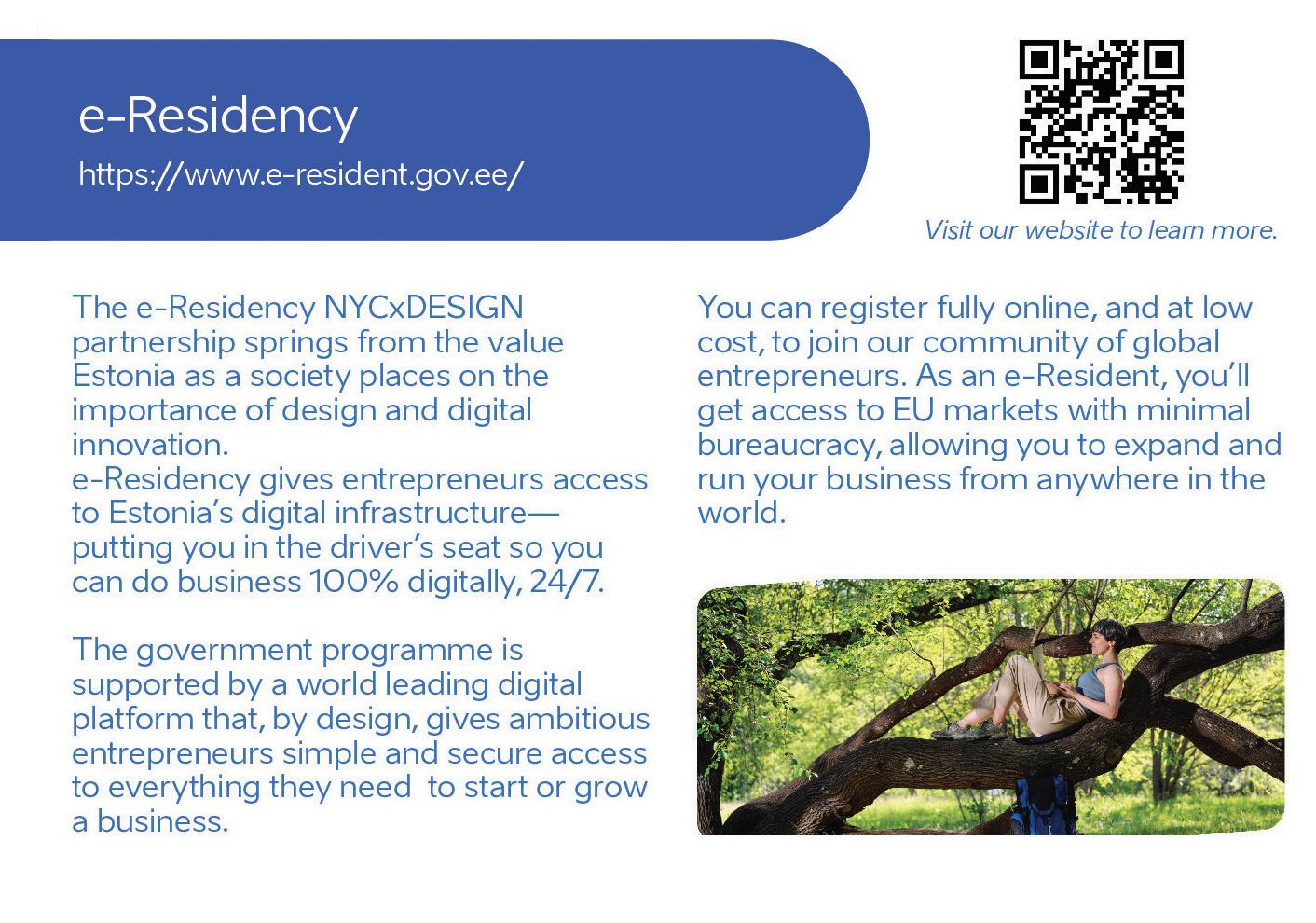
Step into a world where ancient craftsmanship intertwines with cutting-edge design. This segment pays homage to Estonia’s enduring practices, crafting products that stand the test of time. Deeply rooted in a rich heritage, Estonian design fuses traditional skills and motifs with modern sensibilities, resulting in a distinctive blend of the old and the new. Such a fusion is evident in textiles, ceramics, and woodworking, where ancient techniques are not just preserved but ingeniously adapted to contemporary aesthetics. This section celebrates the mastery of craftsmanship handed down through generations, encapsulating the essence of tradition in each piece and highlighting the timeless beauty of Estonian artistry.
www.stellasoomlais.com
Stella Soomlais is developing a wide range of leather bags that are both functional and versatile. In addition to enduring design, they have put circular economy principles into good practice, making them a pioneer in responsible leatherwork. The bags follow a sustainable concept called “Round 2”, that the brand has developed in-house. Circular design enables the products to be reused, repaired, redesigned and material repurposed again. In addition to buying new products it is also possible to rent them or instead buy preloved bags. There are no decorative details on the products, which enables to maximize the use of the material. As part of this process, customers can return the bag if it gets damaged or there’s no use for it anymore. The material is then repurposed into the smaller designs, and the customer receives a credit towards their next purchase.

www.ulfsak.com
“Whichcraft” is a new artisanal rug series by artist Johanna Ulfsak. It combines the craft of slow and traditional textile art with story telling. Decoding semiotic messages, traffic signs, occultism and instructions found in public, this collection creates a new language of signs and symbols, mixing together the past and the present. Each rug consists of the finest Tibetan hand-spun wool and silk and is hand-knotted by Tibetan artisans in the Boudha region of Kathmandu, Nepal.

www.kelpmantextile.com
Scarves by “kelpman textile” are 100% natural, produced in Finland and Estonia from materials made in Europe. The collections are continually being updated while the style remains the same, with patterns and materials that are timeless. The vintage feel is an intentional design element.


www.olustveremois.ee
The “Sahin” stool is a light and durable seat that finds its home as a hallway bench, bedroom night table or spare chair in the kitchen. All the wooden parts of the stool are faceted in the wet wood stage with a drawknife. The Sahin is made using a green woodworking technique that joins the wet and very dry details with a tap and no need for artificial glues or screws. Made with respect for the material, using only hand tools, carefully selecting and felling trees and caring for the environment. The seating pad is hand woven from durable and natural paper cord. The ashwood construction is finished off with oil wax and milk paint.
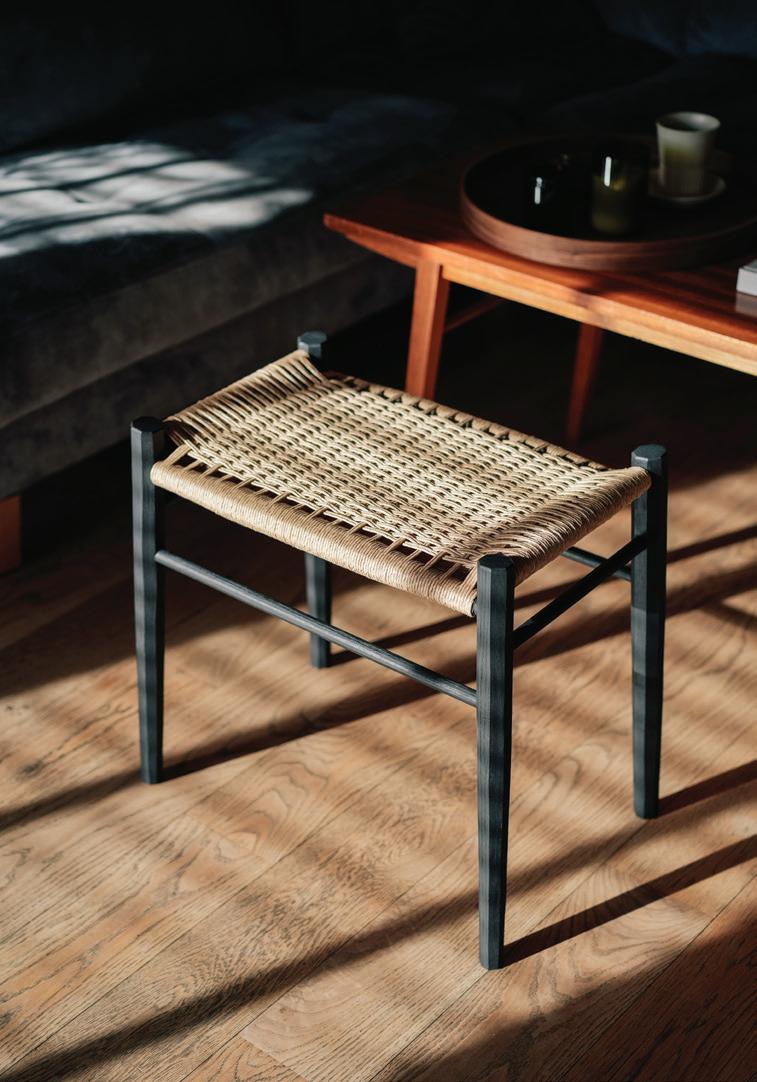
www.summatavet.ee
The 25-kroon silver collector coin “The Estonian History” of the Estonian National Bank is re-designed as a lucky coin and talisman that attracts wealth and success and protects its owner from misfortune. The main challenge of symbol and mythological ‘multiple different-shaped holes’ was to design a tool that would not crack the coin as it was being minted.

www.paikesepuu.ee
The pieces are handmade, mostly using local waste wood. I mainly work with green woodwood that deforms and shifts shapes during drying. This collaboration between me and the forces of nature produces unique forms which would require much more complicated machinery than a simple lathe when working with dry wood.

Crafted on the pottery wheel, the sculptural stoneware vases feature claybodies blending white and iron-bearing clays, often reclaimed from the artist’s studio work. The iron’s diverse presence creates dynamic effects in the wood-fired kiln’s reduction setting, complemented at times by local limonite for visual intrigue. The glaze incorporates 60% ash from residential wood-burning ovens, with firing temperatures soaring to 2345 F (1340 C, cone 12). Sustainable kiln design includes preheating external combustion air, enhancing efficiency and reducing wood consumption. Wood fuel is predominantly reclaimed from a nearby lumber supplier, underscoring the artist’s eco-conscious approach to their craft. These practices not only yield unique vases but also reflect a commitment to environmentally friendly production methods.

Maarja Roolaht, Lennart Mänd, Rünno Kulver
www.ikigi.ee
The open spine binding of “IKIGI notebooks” and the artisanal approach allows covers made from different innovative materials - including expired thermal sleeping bags from life rafts, new material made out of leather scraps, and used paper bags.
The IKIGI brand is backed by three bookbinders, Maarja Roolaht, Lennart Mänd, and Rünno Kulver, all with backgrounds from the Estonian Art Academy. While sharing a common vision on material usage and promoting bookbinding art, each artist maintains their distinct style and professional approach, adding a unique touch to their collaborative work.

www.raiku.co
“RAIKU” is a cleantech company that has developed a breakthrough packaging material and production technology to solve the massive pollution produced by the packaging industry. Plastics and other high-carbon packaging materials are substituted with 100% natural, compostable, beautiful, and shock-absorbing material.

Discover the transformative power of upcycling as Estonian designers masterfully repurpose materials, creating stunning works that challenge conventional notions of waste. As environmental consciousness rises, Estonian design pivots towards sustainability, emphasizing the ingenious repurposing of materials. This portion of the exhibition shines a light on how design breathes new life into potentially discarded items, heralding a new beginning from the end of a product’s lifecycle. Through upcycling, designers and companies strive to minimize waste, crafting durable, repairable products that make a minimal environmental footprint. This approach underscores a commitment to a circular economy, where every product is designed with its next life in mind, embodying principles of sustainability and waste reduction.
www.reetaus.com
As part of the project “Bringing Upmade knowhow to Kenya,” Rivatex, one of Kenya’s bestknown textile companies, continues to conduct waste analysis, test circular design solutions, and implement innovative circular production processes. The three coats in the exhibition illustrate the result of their collaborations, which utilized the surplus fabric generated by the company through the printing process and designing of the product. The project aims to minimize fabric and textile waste, through the Kenyan factory’s innovative and circular UPMADE upcycling approach. The project cooperates with the Estonian Academy of Arts, Tallinn Center of the Stockholm Environmental Institute and Moi University. The project is financed from the funds of the international climate cooperation of the Ministry of Climate.
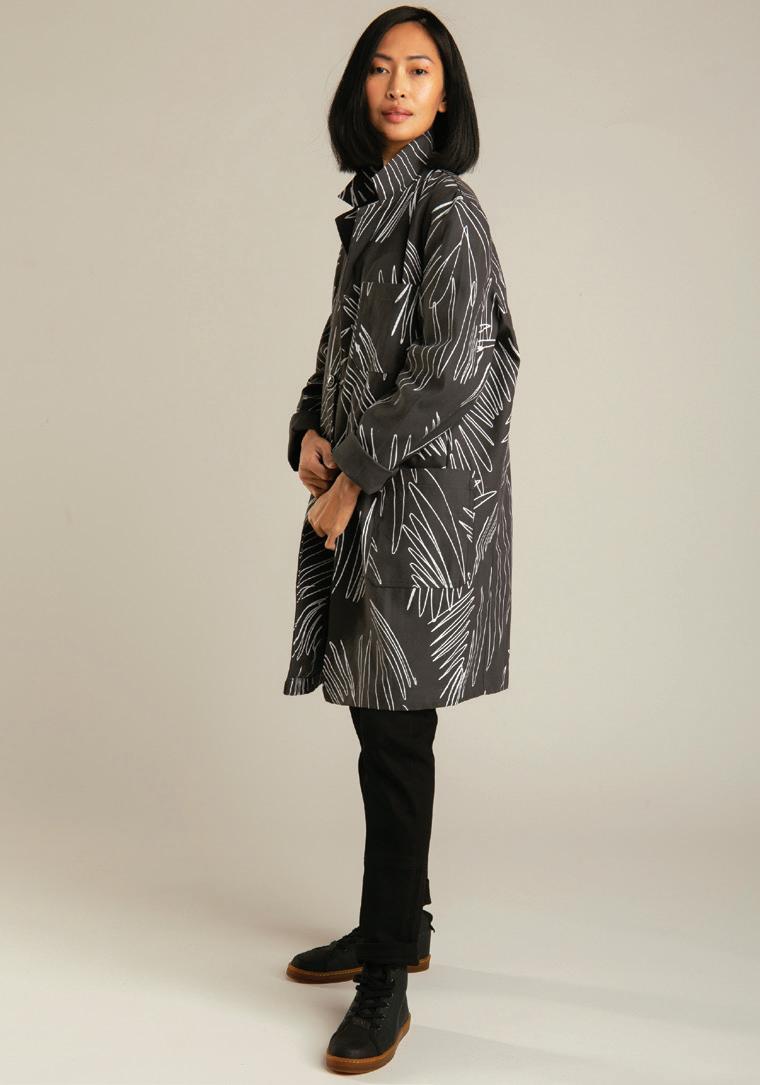
“Reet Aus Upcycled Collection.”
Fashion meets digitalization via QR code, offering complete transparency regarding the product’s manufacturing process, environmental impact, and methods to prolong its lifespan through repair, reuse, upcycling, and recycling.
Reet Aus UPMADE® certified collection applies industrial upcycling. In mass production, 25-40% of fabrics are considered production waste, ending in landfills. The Reet Aus collection turns these leftover fabrics into garments, resulting in a remarkable 75% water reduction, 88% less energy use, and an 80% decrease in CO2 emissions compared to similar products made from virgin material.


Cärol Ott / DiMa
www.carolxott.com
The Cärol Ott “Upcycled in Kenya “ project is a collaboration that merges Estonian design with Kenyan craftsmanship and materials. This project aims to create sustainable and culturally rich products by combining the unique design sensibilities of Cärol Ott with the traditional artisan techniques and materials found in Kenya. The project aims to minimize fabric and textile waste, through the Kenyan factory’s innovative and circular upcycling approach.
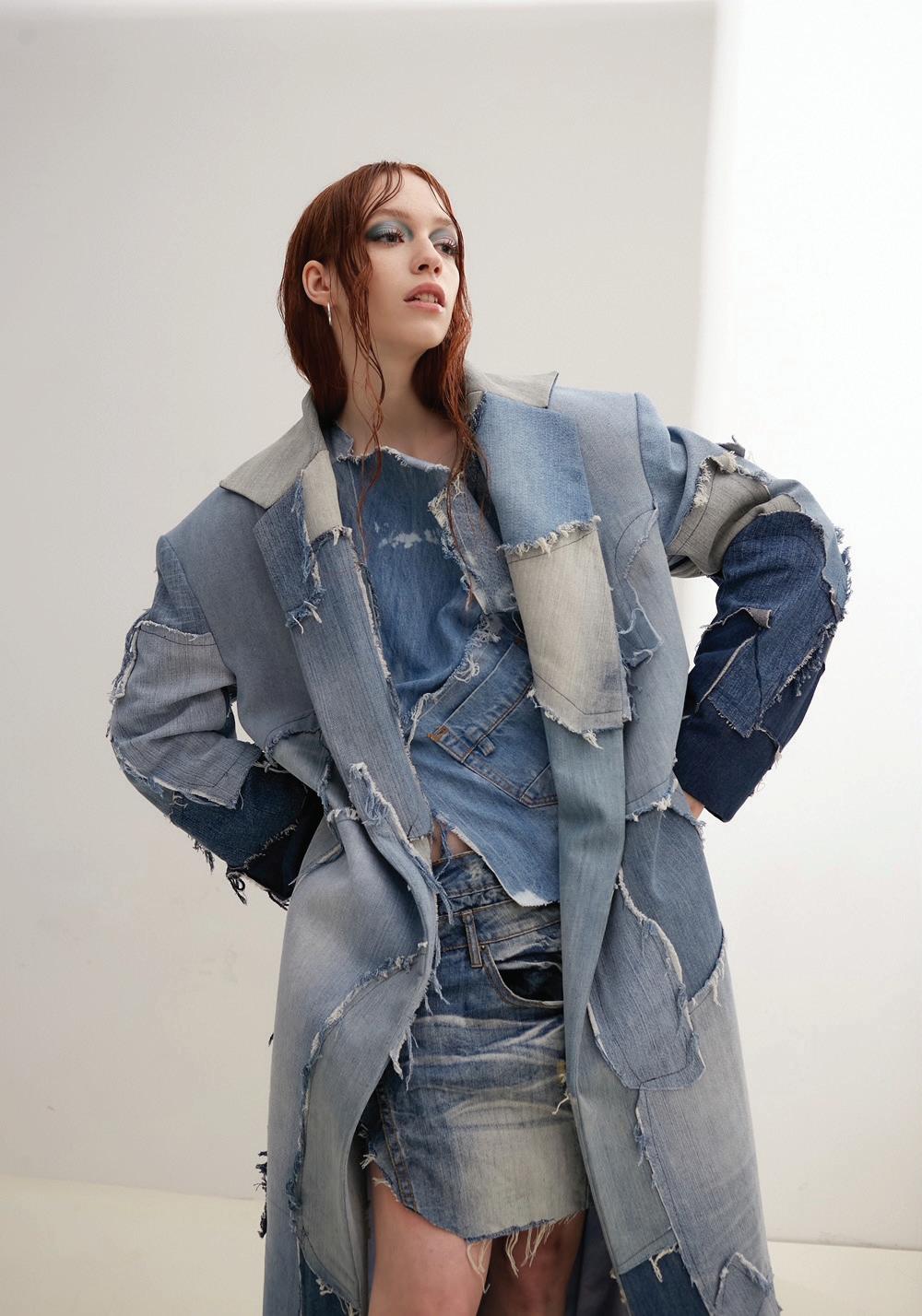
www.sandraluks.com
Sandra’s creations from the “Completely out of Fashion” project emerge primarily from repurposed denim through processes like tearing, weaving and sewing, to form distinctive and wearable design pieces. By deconstructing old jeans down to the thread, she unlocks new possibilities for material innovation, embodying an ethos of environmental consciousness fused with functionality and a signature uniqueness.
 Sandra Luks
Sandra Luks
www.sandraluks.com
Sandra is a multidisciplinary designer whose practice redefines the possibilities of denim transformation. Through different methods she arrived at a new opportunity for one unexpected texture. Unraveled threads from ripping up old jeans come together in a delicate fabric that carries both the fortitude of workwear and the ethereal lightness of feathery lace, a true testament to the enduring power of sustainable design. Through Sandra’s transformative vision “Threads of Transformation”, upcycled denim emerges as more than just a material; it becomes a symbol of possibility, where sustainability, innovation, and beauty converge to shape the future of fashion.

www.dak.ee
These “SITBOARD” stools use skateboards as their seat plates. To be clearer, skateboards that have survived their original use are re-purposed. A bolster has been fitted in a way that covers as small an area of the (raddled) back side of the skateboard as possible. The legs are assembled easily with screws (the holes are already there from the skateboard wheels). Construction is strong and light. The bolsters are made from leftovers from the furniture industry (there are always suitable sizes in the leftovers).

www.estoniandesignhouse.com
The cardboard chair “Katarina” is upcycled from heavy-duty cardboard rolls that were originally used to transport steel roof sheets. The rolls were transformed into chairs, poufs, and tables. Thereby saving material and energy that would otherwise be used to manufacture elements for similar products. Additionally, the upcycling process lowers industrial waste disposal costs.


www.sileluik.com
The “Two Cents“ jewelry collection is made from stretched copper coins. For each earring, a cent is heated up and passed between two revolving steel cylinders - like letting a train rollover it.


www.cervovolante.com
Excitingly imperfect, sustainably beautiful and consciously wild: the “Cervo Volante” brand turns the residual leather of carefully regulated and sustainably hunted red deer from Switzerland and Estonia into unique and eco-friendly shoes and accessories with traces of wildlife as a sign of authenticity.

www.killud.ee
This original jewelry “Killud” is inspired by glimpses of beauty, generally so momentary and passing, but in jewelry eternally perpetuated as still images. Throughout the august, people have worn jewelry for protection and fortune-bringing qualities, and these pieces continue this tradition. The unusual, but natural materials are used with love and creativity, suggesting moments of life and creation, emotion and energy.

www.urmasluus.com
The products in this line are made from old, discarded enamel vessels from the Soviet period. Material with memory is like a document from times past. The philosophy of the product stems from the post-Soviet village life, where all things had to be used “all the way to the end” due to economic difficulties.

 Eva-Karlotta Tatar
Eva-Karlotta Tatar
www.karlottadesign.com
In the circular leather bag collection “3x1”, old leather garments were used to create new value in things that are considered waste. As an outer material, old leather jackets are used which is considered as post-consumer waste, and the inner lining is a production leftover from ECCO shoe factory. The circular economy principles are used in designing this collection, so not only is waste used as a resource but the product’s full life cycle is considered. The design is made with minimal details, and because it is missing a classical lining, separation and recycling are easier.

Delve into the groundbreaking world of Estonian recycling, where waste is not an end, but a new beginning. This section delves into the innovative processes that transform waste into valuable materials, underpinning a design ecosystem focused on regeneration and sustainability. Estonian design advocates for the principle that a product’s end-of-life is as critical as its inception, with a growing emphasis on designing for disassembly. This ensures products can be effortlessly dismantled for recycling, reducing waste. At the forefront of sustainable material development, Estonian researchers and designers are pioneering smart packaging solutions and other materials that are easier to recycle, significantly lowering the environmental impact and leading the charge in ecological design solutions.
www.reetaus.com
The seamless hat is knitted from recycled yarn consisting of 30% of recycled post-consumer textile waste and 70% leftover sheep wool. 30% of post-consumer cotton yarn is mechanically recycled from the post-consumer textile waste collected in Estonia (t-shirts, home textiles, jeans). For production of the hat, the industrial seamless knit machine Stoll 822 KW was chosen. The result is an industrially produced zero-waste design that solves the problem of textile waste. The product is recyclable.


“Reet Aus Recycled Collection.”
Fashion meets digitalisation via QR code, offering complete transparency regarding the product’s manufacturing process, environmental impact, and methods to prolong its lifespan through repair, reuse, upcycling, and recycling.This collection is designed for Team Estonia for the Paris 2024 Olympic Summer Games and crafted entirely from 100% recycled materials. The composition is 50% recycled cotton pre-consumer remnants from Beximco blended with 50% TENCEL™ Lyocell fibers for better quality. This commitment to reusing waste materials underscores Reet Aus’s dedication to advancing the circular economy within the textile industry.
www.reetaus.com Digital Product Passport (DPP)


www.dima.artun.ee
In this process, mechanically shredded textile fibers have been mixed with a binder, after which the carded material is developed into a composite with different properties of thickness and strength by using the pressing method. We aim to highlight its sensory tactile properties, transparency in the material used, and the fact that the novel material is recyclable. The design draws attention to the possibilities of applying non-woven materials made from recycled textiles in the context of industrial design. The created product is a minimal bench. The strength of the chair is based on the vertical panels. In order to create contrast and demonstrate its compatibility with other natural materials, the upper detail is left undefined. It is changeable and playful - just like the material underneath.

www.filaret3d.com
“Filaret” is a startup collecting and then recycling cigarette butts into new materials (new papers, recycled cellulose acetate, unique bioplastic granules and 3D printing filament). They have created a systematic value chain outlining how to collect cigarette butts and how to make that kind of waste stream valuable. Their work is raising awareness and helping to clean the environment of this toxic polluter. To our knowledge, Filaret is the very first company in the world that has 3D printed with cigarette butts.

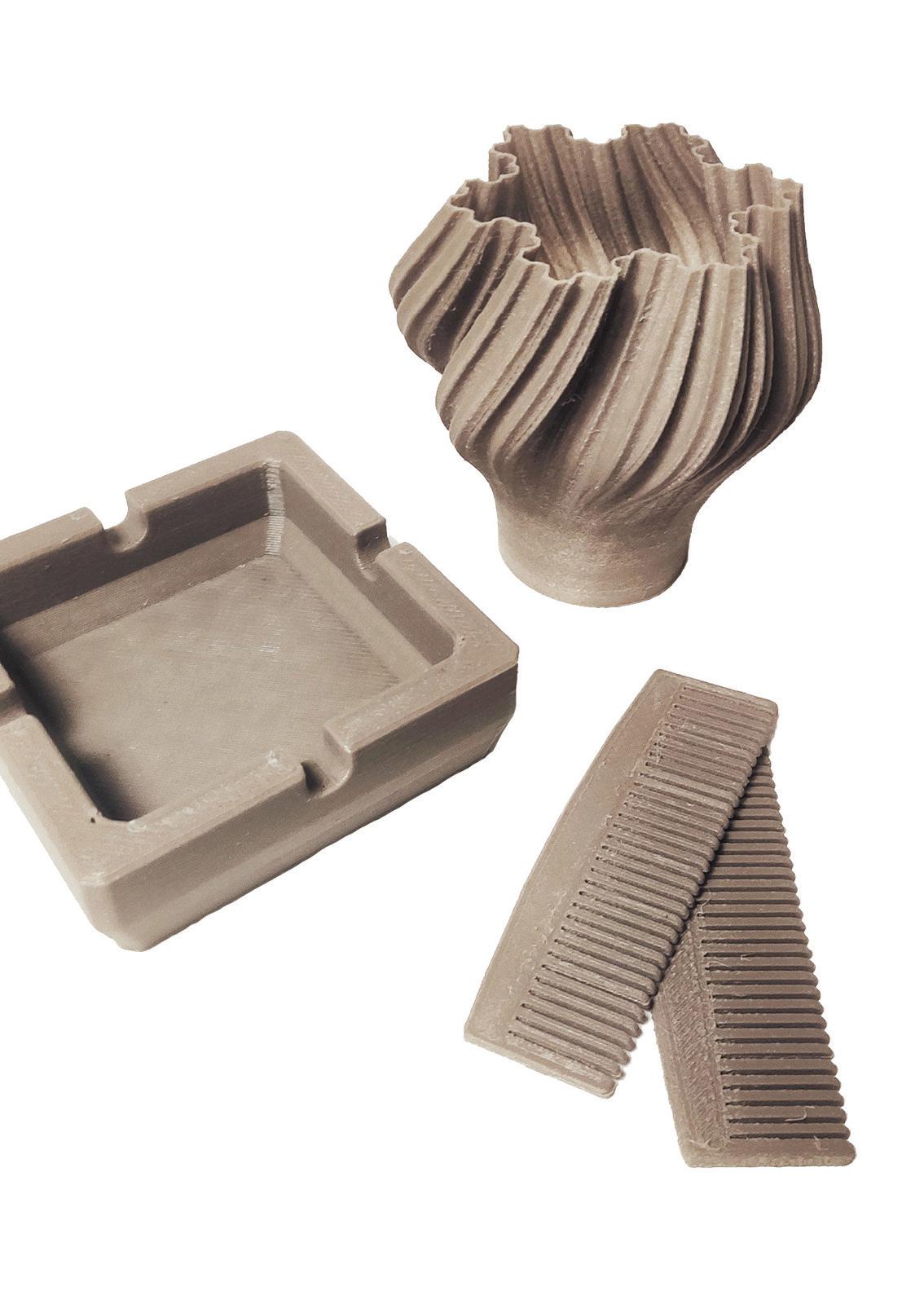
www.heiterx.com
Heiter X, founded by Helis Heiter, is a design and experience studio that explores the intersection of food, art, design, eating, and sustainability.
Mound Collection is inspired by mounds of waste, incorporating materials like hemp, clay, lime, plaster, buckwheat husks, macadamia nut shells, and other residues, including those from Heiter X’s previous installation “Terra Firma” and food waste from events where the installation was exhibited. Each item in the collection is hand-made and unique with its imperfections.

www.hannahsegerkrantz.com
“Kiukivi” is a carbon-negative design element made of hempcrete a natural building material composed of hemp shivs and lime. Kiukivi merges material knowledge with a slow design philosophy to meet current values of sustainability.
 Mariana Laan
Mariana Laan
www.nuudceramics.com
“Nüüd Ceramics” paper porcelain is a ceramic material crafted by blending paper fibers with porcelain, resulting in a lightweight and malleable clay body. Used by ceramic artists for over 30 years, this technique offers a sustainable solution for recycling paper waste. Leftover paper packaging is dissolved in water and mixed with porcelain, reducing the need for pure porcelain by up to 40%. During firing, the paper burns away, leaving a unique texture. Some products incorporate concrete elements, utilizing leftover porcelain scraps to reduce concrete usage by over two times. This eco-friendly approach not only minimizes waste but also lowers production costs, showcasing a commitment to sustainability in ceramic design.

www.studiorailikeiv.com
The small table “Dialogue” is a perfect object to create a compact and cozy corner in your home – in the living room, on the balcony or even in the bathroom. The table is made of recycled porcelain and recycled steel. Both pieces (the tray and the base) are high-quality, elegant, and durable. The tray is attached to the base with magnets, so it is easy to lift it to use elsewhere if needed.

www.elizehiiop.ee
“Elize Hiiop Jewellery” is a fine porcelain jewellery brand of minimalist aesthetics that is gained through the concept of upcycling, recycling and sustainable innovation. The author’s focus has been lately on the study of 3D printable natural fibers and the novel 3D printing of paper porcelain as the innovative technologies offer the opportunity to put historical materials into a new context. Each piece in the display is an unique conceptual artwork and inspired by the essence of being.
“Two Bladed Sword” - tinted recycled porcelain and camel bone upcycled from the broken paper knife that has been engraved into jewellery in order to honor the origin of the material with appreciation and admiration it deserves.

www.estoniandesignhouse.ee
The “EGG jewelry collection” is made from eggshells that are usually discarded. This collection is inspired by recycling and displays the natural beauty of the materials. We use organic ingredients such as charcoal, beetroot, onion, and chlorella for coloring. There are also options for natural eggshell colors from brown all the way up to light green.


www. ideeklaas.ee
Glass production is energy intensive. “Afterparty” jewelry is made from recycled glass and guitar strings. The style of jewelry is guided by the nature of the original material. The label has information about the original products and, if possible, the era, – conveying and valuing history.

www.hytidesign.com
Two qualities give the “ZEN soap dish” meaning – material and function. Crystal clear soda-lime glass, which until now has not been reprocessed or recycled in Estonia, can now be put back into circulation in the form of soap holders. There is a choice of colorless or colored soap holders – the former are made from onetime awards, souvenirs and gifts, while the latter are made from HYTI studio production leftovers.
 Igor Volkov
Igor Volkov
www.lum.ee
A table clock “DC-90 RECYCLED” made from recycled sawdust exhibits a unique texture. The texture of the clock depends on the raw materials utilized during its manufacturing process.

www.woola.io
“Woola” takes waste wool — a material that would otherwise be burned or buried— and turns it into a sustainable alternative to plastic packaging.
Premium e-commerce and luxury retailers use Woola packaging to protect fragile products during shipping and convey a message of sustainability.

Prepare to be amazed as you explore the frontier of material science through the lens of Estonian design. Highlighting Estonia’s rapid adoption of new technologies, this section explores the frontier of material science, showcasing materials designed to sidestep the waste cycle entirely. Estonian designers leverage their tech-savviness to experiment with innovative production methods, giving rise to unique and often groundbreaking materials. Featured are bioplastics, natural fiber composites, and other sustainable alternatives that aim to replace traditional materials with eco-friendly options. This exploration not only emphasizes the innovative spirit of Estonian design but also marks a significant step towards sustainability and recyclability, setting new standards for environmentally conscious design.
www.myceen.com
The materials “Myceen” is developing are a perfect example of circular economy principles. Mycelium composites are grown in an energy efficient production process by combining mushroom mycelium and organic byproducts. As a result these materials are carbon-storing and have functional properties that allows them to potentially replace plastics and problematic composites in construction and interiors. Myceen’s design products have attracted global interest which confirms the solution’s current relevance and need for the future.

www.riinao.com
Riina O is exploring how Symbiotic Culture of Bacteria and Yeast (SCOBY) leftovers generated from the kombucha drink industry can be re-processed into a new, regenerative, vegan, leather-like material called SCOBY-compo and intricately crafted into a collection of handbags “Crafting Organic Waste For Fashion”.

www.riinao.com
The tradition of garden gnomes dates back to ancient Rome when statues of Roman gods were placed in the garden to ensure bountiful harvest by protecting plants and the earth. The belief is that gnomes live underground and possess magical powers to help humans with farming.
“Guardians of the Garden” are visually relatable funny characters, made of regenerative materials, such as eggshell biocomposites using different binders, like gelatine, alginate, xanthan gum, etc. They are built to slowly decompose in the garden, nourishing the earth and plants around them. In times of ecological crises, regenerative and planet-friendly materials and solutions offer a constructive way forward.
 Cärol Ott
Cärol Ott
www.carolxott.com
“carolxott” is a clothing brand for venturous wearer, which offers unique one-of-kind solutions for everyone’s wardrobe. Our clothes tell the stories of coastal living conditions and fisherman villages. Such as the people on islands are special, all their designs are also unique and in small quantities. cxo is keen into new technologies and material upcycling using traditional reference. Cärol Ott is known for her innovative use of seaweed. Her creations not only highlight the beauty of seaweed but also promote environmental consciousness and the importance of using renewable materials in the design industry.

www. estoniandesignhouse.com
This vegan leather handbag project started out of the need to find an alternative material to replace leather, as any leather tanning process is not very eco-friendly. The solution is different plant-based alternative materials, but the problem is that usually one of the important components in these materials is plastic. This collection has been created to test – as the handbag’s outer material the world’s first 100% plastic-free plant-based leather alternative that has reached the production stage. The material is produced in the USA and has a USDA certificate - 100% biobased material. The largest component of this material is natural rubber from rubber trees. The material also contains plant oils and waxes and various vegetable fillers.

Estonian Design House presents: Unique and innovative Nomad Showcase brings together a curated selection of designers and producers who are redefining the concept of sustainability and creativity in their respective fields. From minimalist TV stands to nature-inspired sauna heaters, recycled jewelry to upcycled furniture, each showcased item tells a story of craftsmanship, innovation, and eco-conscious design. Featuring a diverse range of products this showcase is a celebration of artistry and sustainability. With a focus on materials, methods, and mindful production processes, Nomad Showcase invites you to explore a world where design meets sustainability, and where every piece carries a unique blend of creativity and environmental consciousness.
www.estoniandesignhouse.com
“Vurle” Elbow Chair by Elmet Treier, is a versatile piece perfect for dining tables at home, cafes, or restaurants. The designer drew inspiration from the thick Estonian sheepskin, a challenging material that often goes to waste. As a vegetarian, Treier values all life forms and believes in utilizing every part of an animal that has nourished a human, out of respect for the creature. The chair embodies this ethos of respect. Crafted from metal and authentic Estonian sheepskin, the “Vurle” Elbow Chair combines functionality with sustainability, offering a unique and ethical seating option for various settings.

sauna.com
www.huumsauna.com
Nature-inspired “HUUM sauna heaters” combine the age-old Estonian sauna heritage, mild steam and modern technology.
Producer: HUUM OÜ


www.jalg.me
Turn your TV into a design object.
“JALG” is a minimalist TV stand that redefines the way a TV is integrated into an interior, using the iconic cone shape of mid-century design with a blend of modern technology. The combination achieves a very clean visual effect with the functionality of hiding away all of our modern electronic clutter while maintaining minimal aesthetics.
Producer: Esthete Ltd
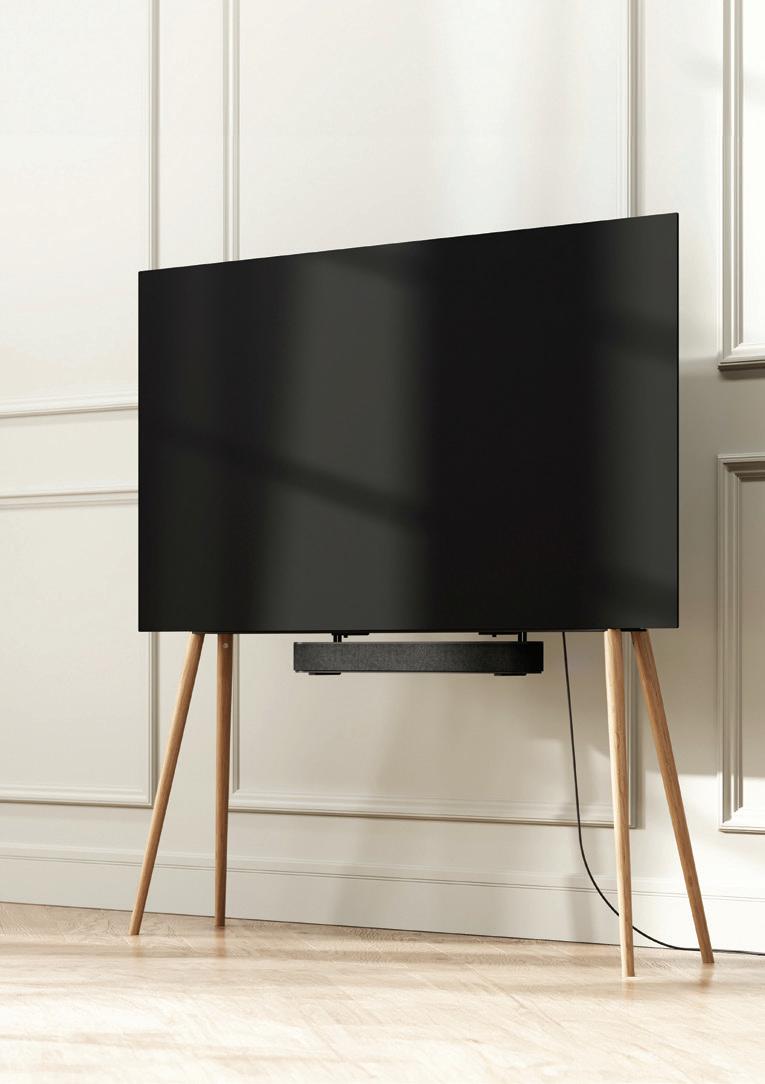
www.dak.ee
Introducing “The Question is in the Sound” speaker, featuring a body crafted from partially recycled plastic, complemented by wood and metal elements. Not only does it deliver exceptional sound quality, but the design also offers a visual delight. This high-quality loudspeaker is ideal for immersing yourself in various music genres. The product family also includes a range of lights in different sizes and shapes under the theme “The Question is in the Light.”

www.mariarasta.com
“Chick“ is Maria Rästa Design’s signature item that has been acknowledged internationally and shown in many Estonian design exhibitions around the world. “Chick“ is an interior accessory that stands out with its playful design. It is mainly used as a small side table near a sofa or bedside stand, as an armchair footrest, or as a plant stand. In addition it has an extra function – to bring a smile to your face!
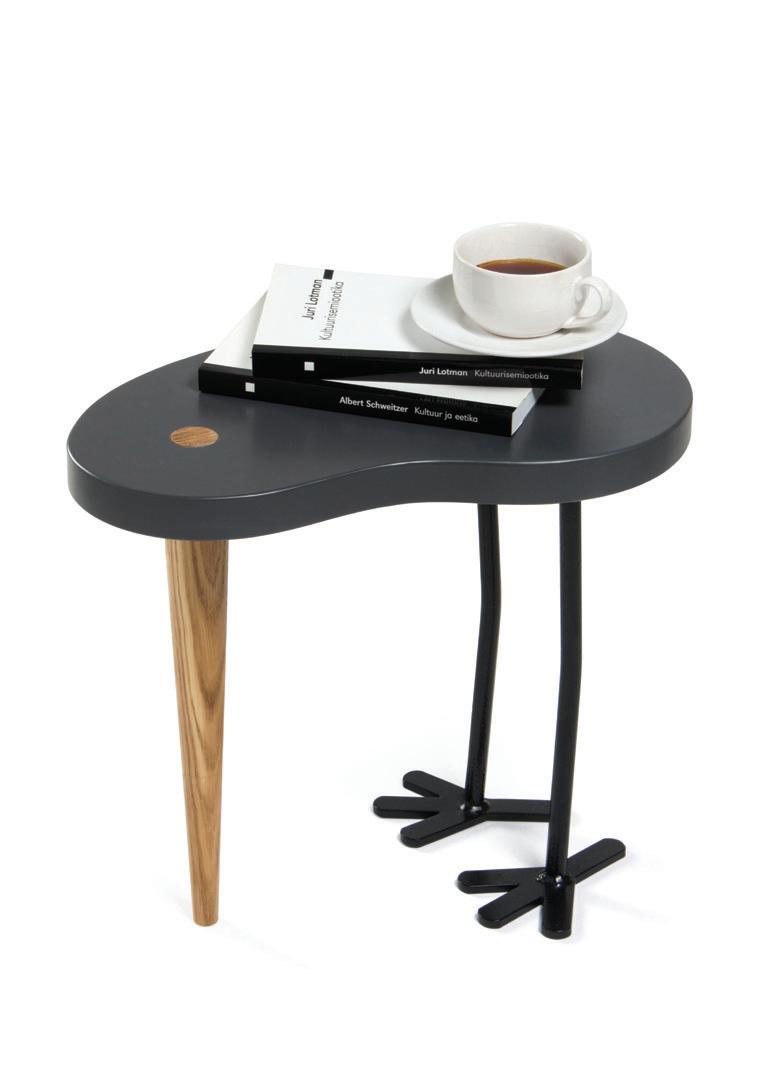
“Step” shelves.
We specialize in crafting durable furniture that is built to last for generations. Based in Estonia, our family-owned business creates each piece using locally sourced plywood. Our commitment to sustainability is evident in our use of birch plywood and oak veneer. In addition to shelves, our collection includes sideboards, wardrobes, tables, and beds. STEP shelves are in different widths and heights. www.radis.ee

www.straipu.com
“Straipu” lighting
Unique design lights on whole world. Straipu LED lamp is energy-saving, environmentally friendly, renewable raw material and high quality of oak wood and birch plywood. Erkki Kivastik came to the lighting design and the creation of his own brand thanks to the desire to createa unique luminaire that is useful, unique and at the same time harmonized completely surrounded.
 Krista Lehari
Krista Lehari
www.kristalehari.com
In a world saturated with buzzwords like recycling and circular economy, the concept of sustainable luxury often conjures images of nature-inspired simplicity or tech-driven innovation. But what does classic luxury mean in the realm of sustainable design? The global design industry thrives on showcasing luxury, with countless product samples enticing us with the allure of the latest designs. Yet, these samples often end up discarded, overlooked in the quest for the next big thing. Krista Leharis “Ettore” challenges this cycle by repurposing mosaic samples from the Bisazza factory into recycled and upcycled luxury creations. This innovative approach embraces a design ethos free from constraints, demonstrating that true luxury lies in reimagining the old to create something new and sustainable.

www.kristelkuslapuu.com
Kristel Kuslapuu is always eager to learn more about slow fashion and a true believer in circular economy. Inspired by politics, cliches and irony, the brand is in constant search of equality. The main goal is supporting a more ethical and inclusive industry. All the collections are either hand made by Kristel Kuslapuu or made in Europe by small family-owned factories in Estonia or Lithuania. The hand-knit sweaters are numbered making them unique pieces of art. The hand-picked yarns and fabrics are all ethical and natural.

www.liisuarro.com
Liisu’s handcrafted work is traditional; there have been basically no changes in the last 10,000 years. An item is crafted out of clay, goes through bisque firing and then glaze firing and in Liisu’s case into a third firing where gold is added.
Innovation in the factory series lies in technological achievements, but the essence of clay and porcelain has remained the same, so the items still go through 2-3 firings. One of the innovations is high temperature gold, which means that the gold is more durable and items decorated with that technique can be washed in a dishwasher. Only a few factories in Europe use this technique.

www.estoniandesignhouse.com
Juhan Soomets is the first in the world to 3D print one-piece lace-up sneakers and boots with a tongue. One of the first to use a multi-material 3D printer to print shoes, this allows the use of materials with different properties and colors. These are new methods for materializing footwear that overcome existing technological limitations and minimize production waste.

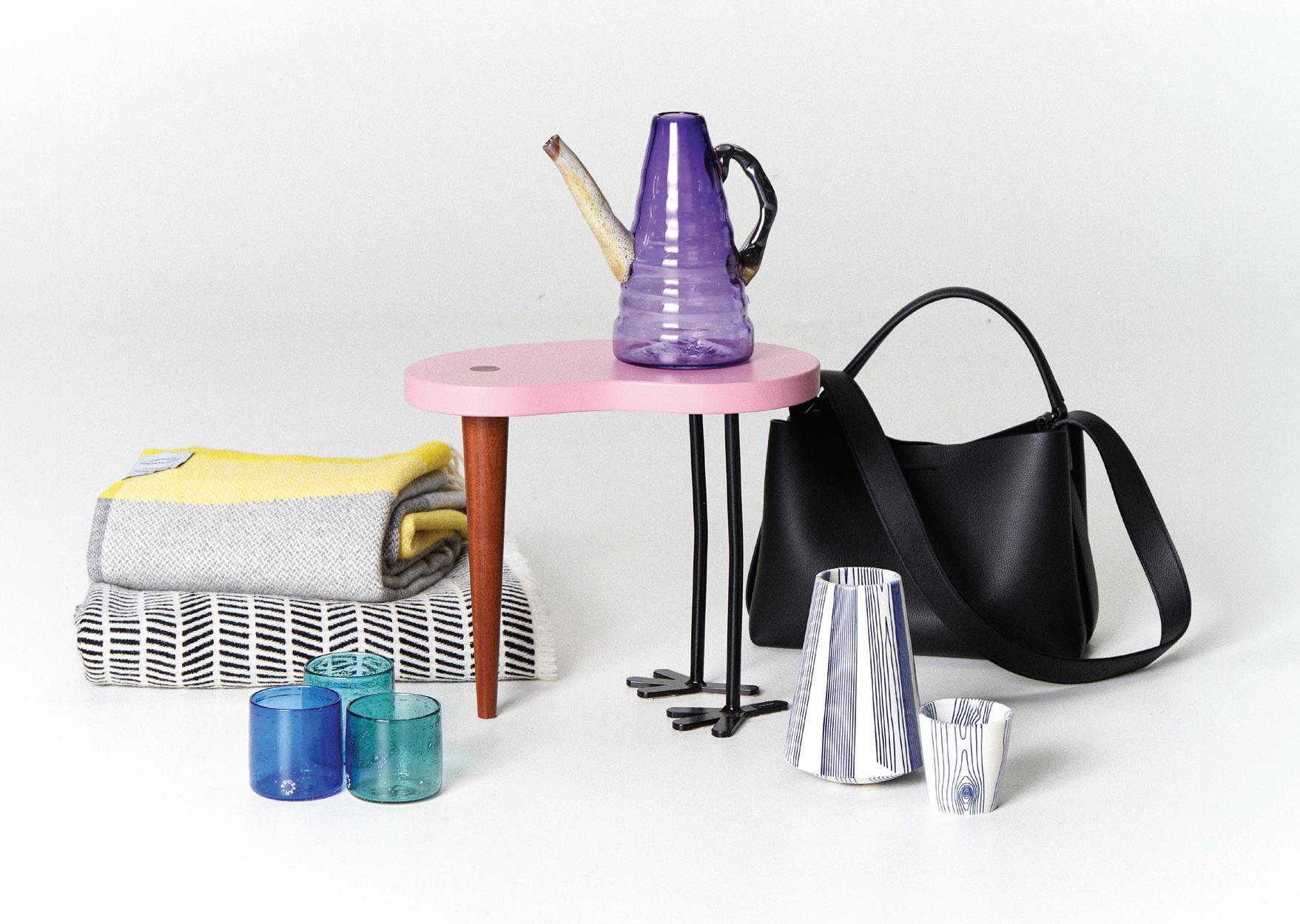

We look forward to meeting you!
PARTICIPATING BRANDS:
Woola, Myceen, Reet Aus, HYTI, kelpman textile, Johanna Ulfsak, Piret Loog, LUKS, LAURASAKS, Cervo
Volante, SILE LUIK, K i l l u d, Heiter X, NüüD, Studio Raili Keiv, Elize Hiiop Jewellery, Tarmo Luisk, LUM,
Filaret, By Urmas Lüüs, Karlotta, Leonardo Design, Olustvere puidukoda / Mirjam ja Markus Pärnamets, Ideeklaas, Hannah Segerkrantz (Kiukivi), Margit Terasmees, IKIGI, Kärt Summatavet, Riina O, RAIKU Bio
Packaging, Andres Ansper, DiMa Estonian Academy of Arts (Sandra Luks, Argo Tamm, Cärol Ott, Reet Aus), HUUM, JALG, Krista Lehari Jewellery, Kristel Kuslapuu, SJX by Juhan Soomets, Maria Rästa Design, Arro Porcelain, Elmet Treier design, Anneli Tammik, Radis and Straipu.
PHOTO CREDITS:
Evert Palmets, Olga Makina, Ankit Shakya, Virge Viertek; Ken Oja, Birgit Loit, Riina Varol, Kristjan Mõru, Kärt Summatavet, Aurelia Minev, Õie Ellen Agu, Maarja Roolaht, Madis Palm, Beth Marsella, Piret Puppart,
Tarmo Luisk, Sandra Luks, Mauricio Zelaya, Tiit Veermäe, Eva-Karlotta Tatar, Sohvi Viik, Silver Mikiver, Igor Volkov, Elize Hiiop, Renee Altrov, Triinu Kööba, Pilleli Läets, Kevin Loigu, Ines-Issa Villido, Kalli Sein, (2006), Terje Ugandi, Katrin Press, Kertin Vasser, Yao Wang, Riina Õun, Mara Gunja, Cärol Ott, Johannes Arro, Andrus Kiisküla, Aili Paat, Juhan Soomets, Veiko Kallas, Salvador, Johann Kööp, Elmet Trier, Liis Mutli and private archives.
SPECIAL THANKS TO:
Surya Vanka, Anthony Luciano, Jaanika Peerna, Kirke Tatar, Kyle Reinhart, Eva-Karlotta Tatar
Estonian Estonian Association of Designers
Tallinn Design Festival
Ankru 8-7, Tallinn
www.edl.ee, edl@edl.ee
www.tallinndesignfestival.com
Estonian Design House showroom
Estonia pst 9 /Solaris, Tallinn
Online shop: www.estoniandesignhouse.com
Estonian Academy of Art
Põhja pst 7, Tallinn
www.artun.ee
www.dima.artun.ee
e-Residency
Sepise 7. Tallinn
www.e-resident.gov.ee
#upmadeinEE #NYCxDESIGN